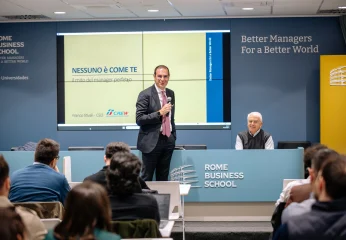Article of the week - Evangelos Kremmydas

HR Management as a value-adding contributor
by Evangelos Kremmydas (Greece), an outstanding Rome Business School’s student.
To begin with, by adding value we mean helping the employees and the organization itself to gain value in a measurable way. In the next paragraphs, we will briefly present two examples of HR Managers that are adding value to their organization via their work.
The first example is Hollie Delaney, Director of Human Resources at Zappos. Ms. Delaney emphasizes the company’s customer orientation by defining Zappos not as a company that sells shoes but as a customer service company that just happens to sell shoes. In order to formulate the core values of the company, all the employees were actively involved. Their responses to specific questionnaires were filtered and the following core values of Zappos.com were listed:
1. Deliver WOW through Service
2. Embrace and drive change
3. Create fun and a little weirdness
4. Be adventurous, creative and open minded
5. Pursue growth and learning
6. Build open and honest relationships
7. Build a positive Team and Family Spirit
8. Do more with less
9. Be passionate and determined
10. Be humble
In order to focus on those values from an HR perspective, the following new practices were applied:
Regarding recruiting, interviews are based 50% on culture fit
On-boarding training consists in a 4 weeks training that focuses on the culture and fit of the company
Any potential employee who decides to quit after the four weeks of training is offered a full month’s salary. This action shows Zappos’ commitment and respect towards all its employees, including those who decide to leave the company after their initial training.
Hiring slowly, firing quickly. At Zappos a lot of emphasis is placed upon culture fit. As a result, people are carefully screened before being hired. However, if, at a later point, it is realized that an employee is not a part of the culture of the company, this is a sufficient reason for him/her to be asked to leave.
We can observe that the first two and fourth practices are related to the establishment of a high performance work system, since the emphasis is placed on the culture fit and thorough training is obligatory during the first four months of work. In this case, Delaney acts not only as a Culture and Change Steward but also as a Strategy Architect, since those roles contribute to the creation of human resource practices that support the organization’s cultural values, that are also in alignment with the core values of the company.
The second example is Laszlo Bock SVP, People Operations at Google. According to Bock, Google’s success in recruiting stems from three core elements:
1. Setting an incredibly high bar regarding the quality of the employees and never compromise on it.
2. Assessing candidates objectively with scientifically proven criteria, procedures and questions.
3. Providing candidates with a reason/vision to join.
Regarding the benefits, Google has made investments in the non-standard benefits provided to its employees, which range from micro-kitchens to dry cleaning services and car wash facilities. According to Bock, the purpose of those benefits is to create a sense of community and bring people together. In his opinion, innovation cannot be manufactured in an organization, however certain conditions can be created in order to maximize the probabilities of innovative ideas appearing and ideas flowing freely throughout it. In this example, it becomes apparent that Bock is acting as a Culture Steward, since the above practice amplifies the value of innovation that already exists in Google.
Also, there is a very specific rule that regulates the composition of Google’s HR Department. Bock calls it the rule of the three thirds. One third of the people working at Google’s HR department are accomplished HR professionals and come from a traditional HR background; another third has a strategy background and is usually made up of consultants; and the final third is composed of people that have advanced knowledge in the fields of analytics and usually hold a degree in, for example. statistics or mathematics. In this way, Google’s HR Department combines the experience of HR professionals with the acumen of strategist consultants and the experimental spirit of data analysts. In this case, Bock is evidently acting as a Business Ally, since the composition of Google’s HR Department enables it to cooperate harmoniously with managers from different departments in order to achieve the organization’s strategic goals.
From all the above, it becomes clear that successful HR managers establish practices that are in alignment with the culture promoted by their organizations and also go beyond the traditional HR manager role by expanding into other organizational strategic management areas.
References
1) Dessler, G. (2013). Introduction to Human Resource Management. In: Human Resource Management. 13th ed. Essex: Pearson. 30, 32-48.
2) Laszlo Bock on Google’s Approach to HR. (2014). Laszlo Bock on Google’s Approach to HR. [Online Video]. 28 February 2014. Available from: http://www.youtube.com/watch?v=XGw9iARGirQ. [Accessed: 29 October 2014].
3) The Best Recruiter at Google | Talent Connect San Francisco 2014. (2014). The Best Recruiter at Google | Talent Connect San Francisco 2014. [Online Video]. 23 October 2014. Available from: http://www.youtube.com/watch?v=hvebAGerh88. [Accessed: 29 October 2014].
4) Hollie Delaney, HR Director, Zappos.com. (2014). Hollie Delaney, HR Director, Zappos.com. [Online Video]. 19 September. Available from: http://www.youtube.com/watch?v=dllEIA54HA4. [Accessed: 29 October 2014].
Evangelos Kremmydas (HR Generalist)




